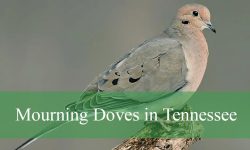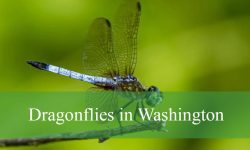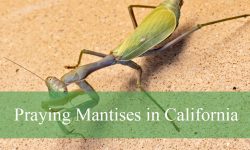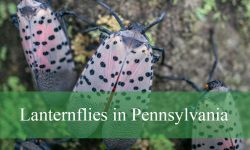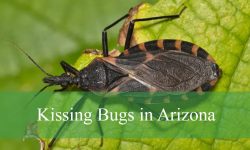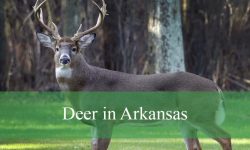Butterflies add vibrant color and charm to Georgia’s natural landscapes. From gardens to forests, these delicate creatures bring life and movement, attracting the attention of nature enthusiasts and photographers. The variety of butterflies in Georgia makes the state a great place to observe these fascinating insects.
This article showcases 25 beautiful butterfly species found throughout Georgia. Each butterfly is described with key identification features and behaviors, helping you recognize them in their natural habitats. From the bold Eastern Tiger Swallowtail to the subtle Red-banded Hairstreak, you’ll discover what makes each species unique.
Butterflies not only delight with their colors but also play important roles in pollination and supporting ecosystems. Learning about them deepens appreciation and encourages efforts to protect their habitats. Get ready to meet some of Georgia’s most stunning butterflies.
Common Butterflies Found in Georgia
Eastern Tiger Swallowtail (Papilio glaucus)
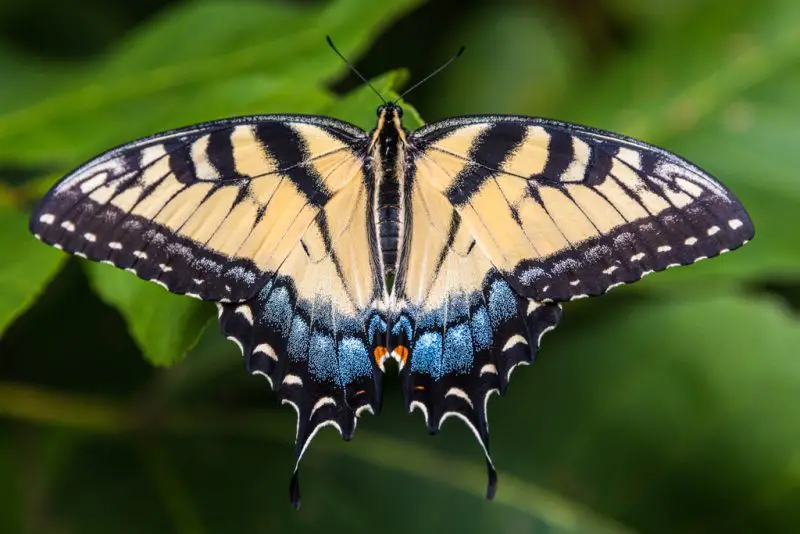
The Eastern Tiger Swallowtail is a striking butterfly known for its large wingspan and vivid coloration. As Georgia’s official state butterfly, it is easily recognized by its bright yellow wings adorned with bold black tiger-like stripes. Males tend to have brighter yellow and more pronounced markings, while females may also appear in a darker, almost black form that mimics toxic species for protection.
This butterfly thrives in various habitats throughout Georgia, including woodlands, suburban gardens, and riverbanks. It typically lays eggs on host trees such as tulip poplar, wild cherry, and sweetbay magnolia. The caterpillars are green with blue and orange eyespots, mimicking a snake to scare off predators before transforming into chrysalises.
A fun fact about the Eastern Tiger Swallowtail is that it was one of the first butterflies to be scientifically described in North America. With a wingspan that can reach over 5 inches, it is a frequent sight across the state from spring through early fall and a favorite among local butterfly watchers.
Monarch (Danaus plexippus)
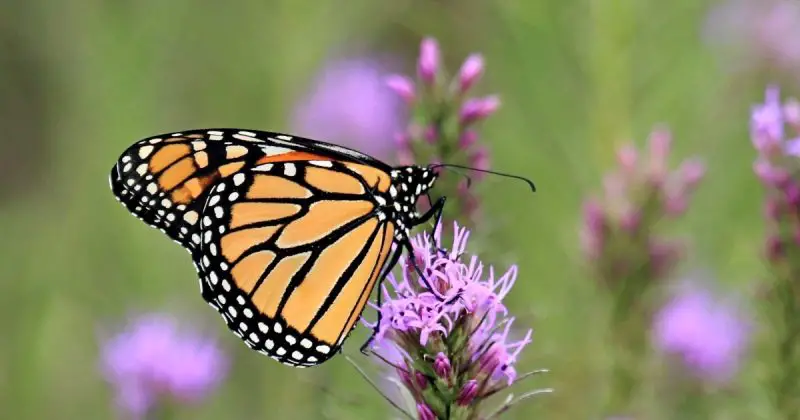
The Monarch butterfly is perhaps the most iconic butterfly species in North America. It features brilliant orange wings with black veins and white-spotted black borders. These markings not only serve as beautiful identification features but also warn predators of its toxicity, which it acquires from feeding on milkweed during its larval stage.
In Georgia, Monarchs are commonly seen during their northward and southward migrations, especially in open fields, meadows, and gardens rich in milkweed. Females will only lay their eggs on milkweed species, which serve as the sole food source for their caterpillars. The adult butterflies feed on nectar from a variety of flowers, including goldenrod and aster.
A fascinating fact about Monarchs is that their entire migration cycle is completed over several generations. No single butterfly completes the round trip between North America and central Mexico, making their migration one of the most unique and complex journeys in the insect world.
Gulf Fritillary (Agraulis vanillae)

The Gulf Fritillary is a dazzling butterfly with glowing orange upper wings marked by black spots and a row of faint lines. The undersides of its wings are a rich brown and silver, covered in bright metallic white spots that glint in the sunlight. Its long, narrow wings give it a distinct flight pattern that is quick and erratic.
This butterfly is especially common in the southern regions of Georgia where passionflower vines grow, which serve as both nectar sources and host plants. The adult butterflies can be found in open spaces like gardens, roadsides, and fields. Caterpillars are bright orange with black spines, feeding on passionflower leaves with voracious appetite.
A fun fact about Gulf Fritillaries is that males are highly territorial and will chase away rivals from their preferred perching spots. Despite their aggressive aerial behavior, they are harmless and add a lively, colorful presence to southern gardens and natural areas.
Black Swallowtail (Papilio polyxenes)
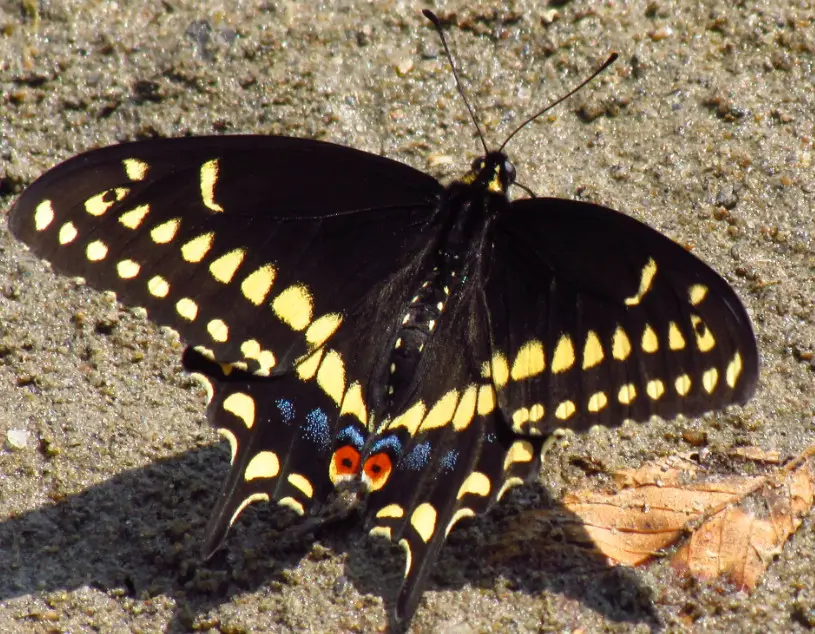
The Black Swallowtail is a familiar butterfly in many gardens and farms across Georgia. It has black wings with two rows of yellow spots and a splash of blue and red near the hindwings. Females have more blue shading than males, and the bright colors serve as a warning to predators that it may be distasteful.
This butterfly is often found in herb and vegetable gardens, especially where plants like parsley, dill, fennel, and carrots grow. These are the preferred host plants for its caterpillars, which go through several color stages, from brownish camouflaged young larvae to bright green mature ones with black stripes and yellow dots. Adults are commonly seen fluttering low to the ground, seeking nectar and suitable places to lay eggs.
One fascinating trait of the Black Swallowtail caterpillar is its defense organ called an osmeterium. When disturbed, the caterpillar extends this orange, forked gland from behind its head, releasing a pungent smell that deters predators like birds and small mammals.
Spicebush Swallowtail (Papilio troilus)
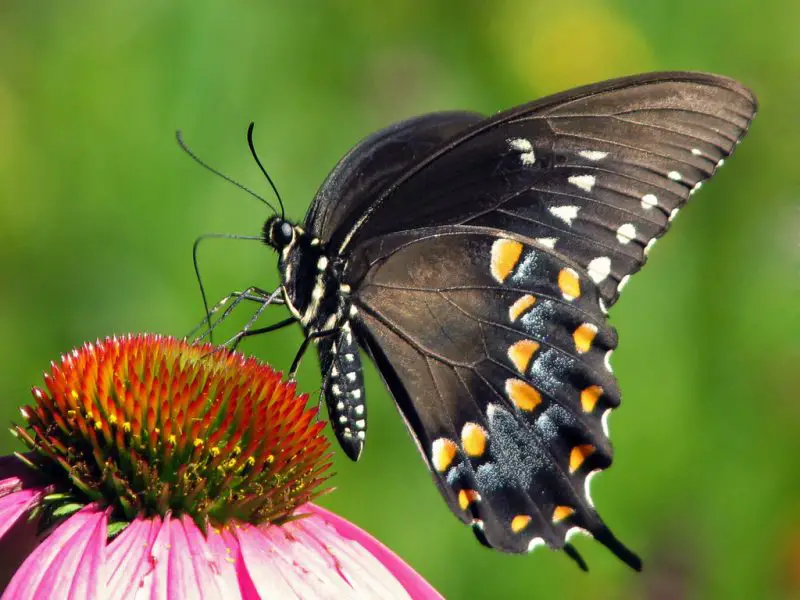
The Spicebush Swallowtail is one of Georgia’s most elegant butterflies, with velvety black wings that shimmer with iridescent blue or green on the hindwings. Its outer edges are dotted with pale spots, and the underside of the hindwings features subtle orange crescents and a row of bluish spots that add to its visual appeal.
This species prefers shady woodlands, forest edges, and damp areas where its host plants—spicebush and sassafras—are abundant. Females lay eggs on the underside of these plants’ leaves, and the caterpillars create leaf shelters using silk to hide from predators. These larvae have a bright green body and large eye-like spots that mimic snakes to scare away threats.
A fun fact about the Spicebush Swallowtail is that it is a master of mimicry. Not only do the caterpillars resemble small snakes, but the adult butterfly also mimics the poisonous Pipevine Swallowtail to gain protection from predators despite being harmless itself.
Pipevine Swallowtail (Battus philenor)
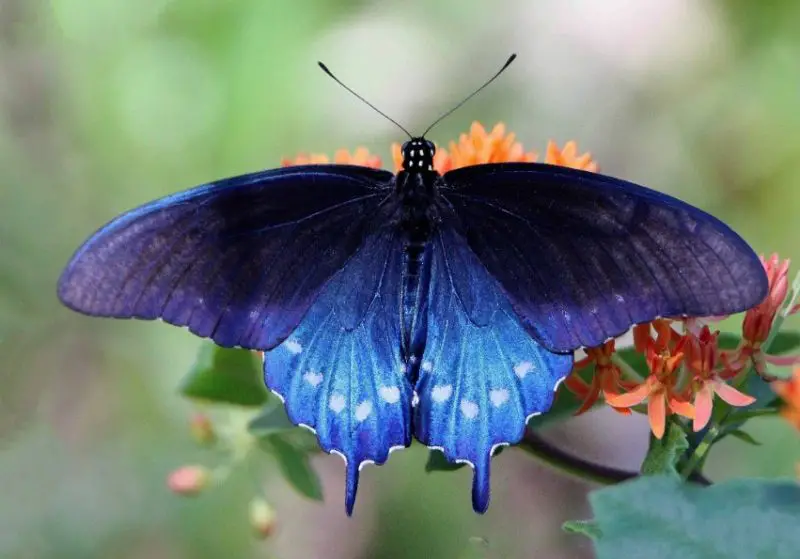
The Pipevine Swallowtail is a stunning butterfly known for its iridescent blue hindwings and distinctive orange spots on the underside of the wings. From above, the butterfly appears mostly black with a metallic blue sheen on the back wings, especially vivid in males. The underside is more colorful, with orange and white spots along the hindwings that make it easy to identify during flight or when resting.
This species is commonly found in woodland edges, shaded gardens, and areas where its host plant—pipevine (Aristolochia species)—grows. In Georgia, it often inhabits moist forests and stream corridors. The caterpillars feed on pipevine leaves, which contain toxic compounds that make the butterfly distasteful to predators. As a result, many other butterflies mimic its appearance for protection.
A fun fact about the Pipevine Swallowtail is that it’s part of a mimicry ring. Several other butterflies, including the Spicebush Swallowtail and dark-form female Tiger Swallowtails, imitate its dark appearance to fool predators into thinking they are just as unpalatable.
Common Buckeye (Junonia coenia)
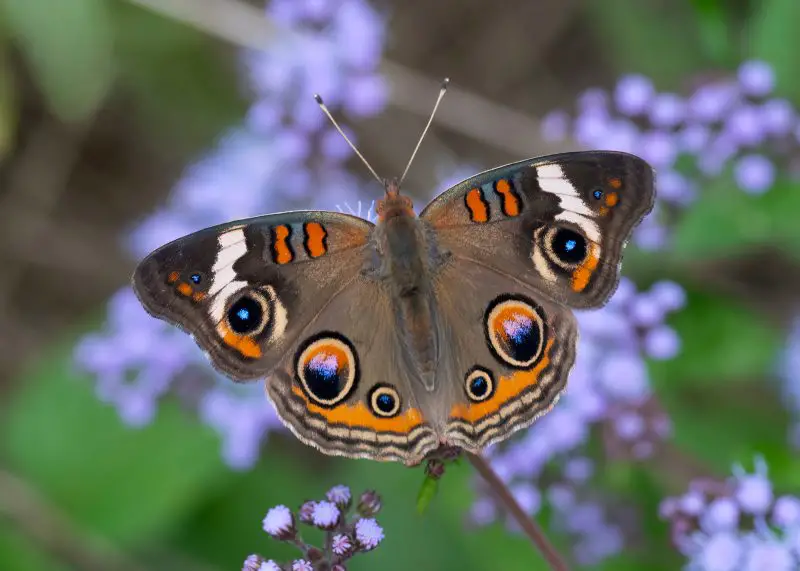
The Common Buckeye is one of the most easily recognized butterflies thanks to its bold, eye-like markings. Its wings are a mix of brown, tan, and orange tones, but the large, circular eyespots on both the forewings and hindwings stand out vividly. These eyespots serve as a defense mechanism, deterring predators by mimicking the eyes of larger animals.
In Georgia, Common Buckeyes are typically seen in open sunny habitats such as fields, roadsides, and grassy meadows. They are especially abundant during the warmer months and are often found basking with wings open. Their caterpillars feed on plants like plantain, toadflax, and snapdragons, which are common in disturbed areas.
A fascinating fact is that Buckeyes are migratory butterflies. While some populations overwinter in the southern United States, others travel northward in spring and summer, contributing to seasonal population booms in states like Georgia.
Zebra Longwing (Heliconius charithonia)
![]()
The Zebra Longwing is an elegant butterfly with long, narrow wings patterned in black and pale yellow stripes, resembling the pattern of a zebra. Its slow, graceful flight and soft fluttering make it stand out from other butterflies. It often glides more than it flaps, creating a peaceful and mesmerizing movement through the air.
Zebra Longwings are typically found in subtropical woodlands, shaded gardens, and forest edges in southern Georgia. They prefer habitats where passionflower vines are present, as these serve as the host plants for their caterpillars. The adults feed on nectar from flowers but are also one of the few butterflies that consume pollen, which helps them live longer than most other species.
A fun fact about the Zebra Longwing is its social roosting behavior. At night, groups of up to 60 butterflies may gather together on tree branches to sleep, providing safety in numbers and making them one of the few butterflies with communal resting habits.
Painted Lady (Vanessa cardui)
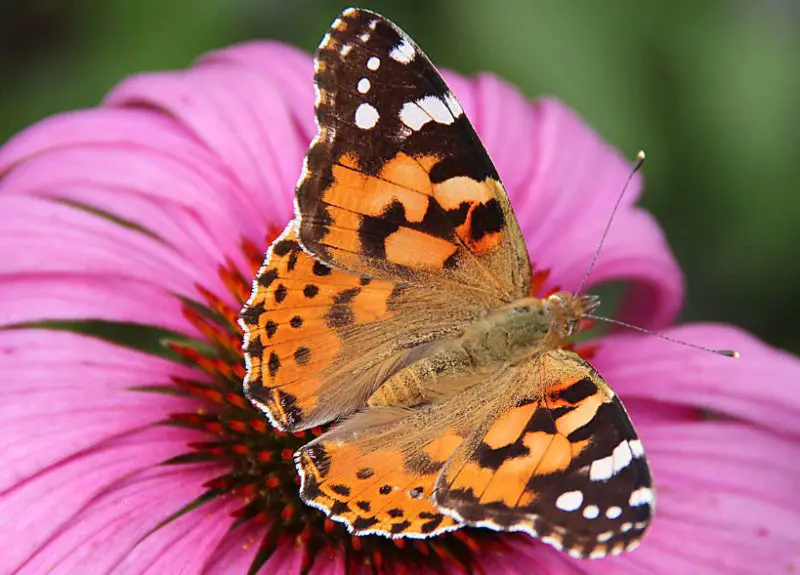
The Painted Lady is one of the most widespread butterfly species in the world and is easily identified by its orange, black, and white mottled wings. Its forewings have black tips dotted with white spots, while the hindwings display rows of small eyespots. When the wings are closed, the undersides blend with the environment, providing excellent camouflage.
In Georgia, Painted Ladies are commonly found in gardens, meadows, and open areas, especially where wildflowers bloom in abundance. They are strong fliers and can appear in large numbers during migration events. The caterpillars feed on a wide variety of host plants, including thistle, hollyhock, and mallow.
A remarkable fact is that the Painted Lady is a global traveler. It holds the record for the longest-known continuous butterfly migration, spanning thousands of miles from Africa to Europe and across continents in North America. In Georgia, they often show up in waves during favorable weather conditions and floral blooms.
Red Admiral (Vanessa atalanta)
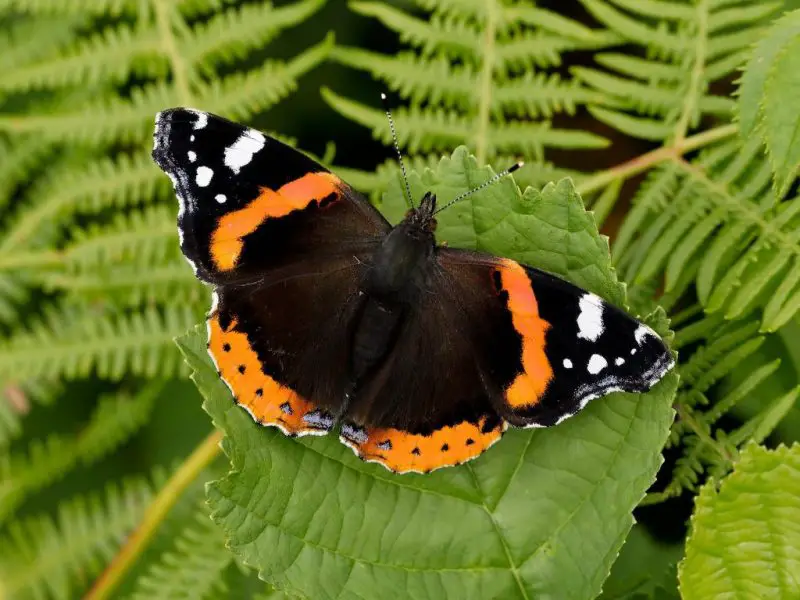
The Red Admiral is a bold and energetic butterfly with striking black wings edged in red-orange bands and white spots on the forewings. The vivid contrast makes it unmistakable in both flight and when perched. The undersides are more muted in color, allowing it to blend with tree bark and leaf litter when resting with closed wings.
Red Admirals are common throughout Georgia and can be found in gardens, woodlands, and near moist areas like riverbanks. They are drawn to flowers for nectar but also have a strong attraction to fermenting fruits and tree sap. Caterpillars feed on nettles, and adults can be seen year-round in mild southern areas.
A fun fact is that Red Admirals are known for their curious and fearless behavior. They often approach humans closely and will even land on people, especially those wearing bright colors or scented lotions. Their inquisitive nature and brilliant markings make them a delight to encounter in the wild.
Cloudless Sulphur (Phoebis sennae)

The Cloudless Sulphur is a large, lemon-yellow butterfly known for its swift and purposeful flight. Its bright, unmarked yellow wings make it easy to identify in the field, especially in sunny open areas where it zooms past at high speeds. Males are a uniform yellow, while females may show faint spots or a paler hue with slightly greenish tones.
This species is widespread in Georgia, particularly during the warmer months, and is often found in open fields, roadsides, and gardens where host plants such as senna and cassia grow. The caterpillars feed on the leaves of these legumes, while adults feed on nectar from hibiscus, lantana, and other colorful blooms. Their fast flight and strong migratory behavior allow them to travel great distances across the southern U.S.
A fun fact about the Cloudless Sulphur is that it is one of the few butterfly species capable of long-distance migration in the southeastern U.S., with some individuals traveling hundreds of miles during seasonal movements, often mistaken for falling yellow leaves in flight.
American Lady (Vanessa virginiensis)

The American Lady is a vibrant orange and brown butterfly often confused with the Painted Lady but distinguishable by two large, unmistakable eyespots on the underside of the hindwings. The upper side of the wings features vivid orange patches, white markings, and dark brown edges, creating a bold, beautiful pattern.
In Georgia, American Ladies are common in open fields, woodland edges, and gardens filled with nectar-rich flowers. The caterpillars feed on host plants such as everlasting (Gnaphalium), pussytoes (Antennaria), and ironweed. Adults are frequently seen basking with open wings or fluttering low in search of nectar from native wildflowers.
A unique trait of the American Lady is its ability to overwinter in the southern parts of Georgia. Its distinct two eyespots on the wing undersides help deter predators and also provide a reliable way to tell it apart from its close cousin, the Painted Lady, which has four smaller eyespots.
Silver-spotted Skipper (Epargyreus clarus)
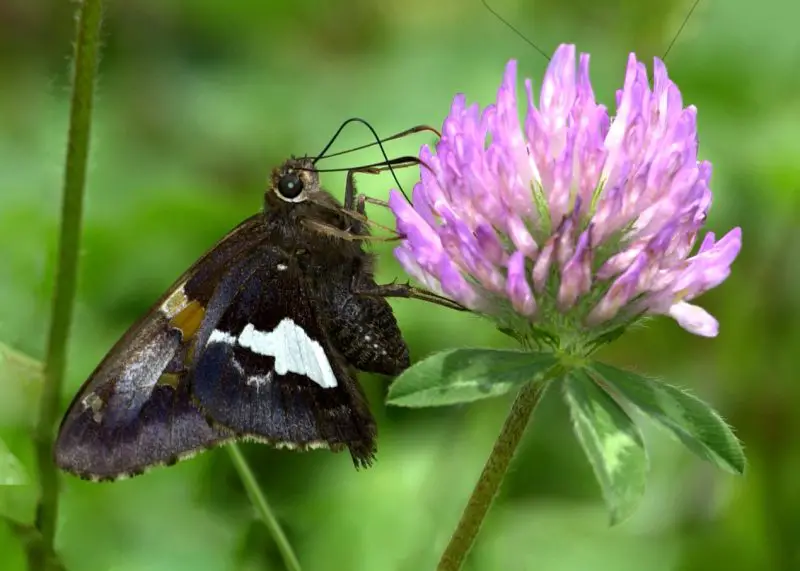
The Silver-spotted Skipper is one of the largest and most recognizable skippers in North America. It is characterized by its dark brown wings and a large, silvery-white spot on the underside of each hindwing. Its robust body, hooked antennae, and quick, skipping flight make it stand out among butterflies.
This species is widespread in Georgia and typically found in open woodlands, gardens, and along roadsides where leguminous plants such as black locust, wisteria, and false indigo thrive. The caterpillars feed on these plants and construct leaf shelters in which they rest during the day. Adults visit flowers like thistles and clovers for nectar, often hovering briefly before landing.
A fun fact is that Silver-spotted Skipper caterpillars create silk-lined leaf tents to hide from predators during the day. At night, they emerge to feed. These shelters offer protection and are one of the signature behaviors of this species.
Cabbage White (Pieris rapae)
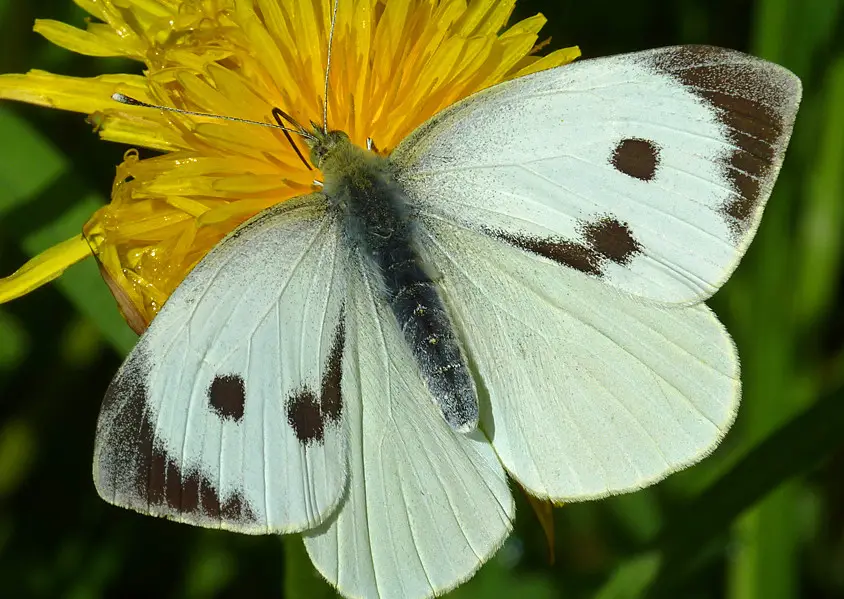
The Cabbage White is a small, delicate butterfly with pale white wings and distinct black markings. Males typically have one black spot on each forewing, while females have two. The underside of the wings is pale yellow or greenish, providing camouflage against leaves. Though not showy, its fluttering presence is familiar to many gardeners.
This species is extremely common in Georgia, especially in suburban gardens, parks, and vegetable patches. The caterpillars feed on members of the mustard family, including cabbage, broccoli, kale, and other cruciferous crops. Adults are active throughout much of the year and are among the first butterflies to appear in early spring.
A well-known fact about the Cabbage White is its status as an introduced species from Europe. Since its arrival in the 1800s, it has spread rapidly across North America and become one of the most abundant butterflies, especially in agricultural settings where its larvae are sometimes considered pests.
Pearl Crescent (Phyciodes tharos)
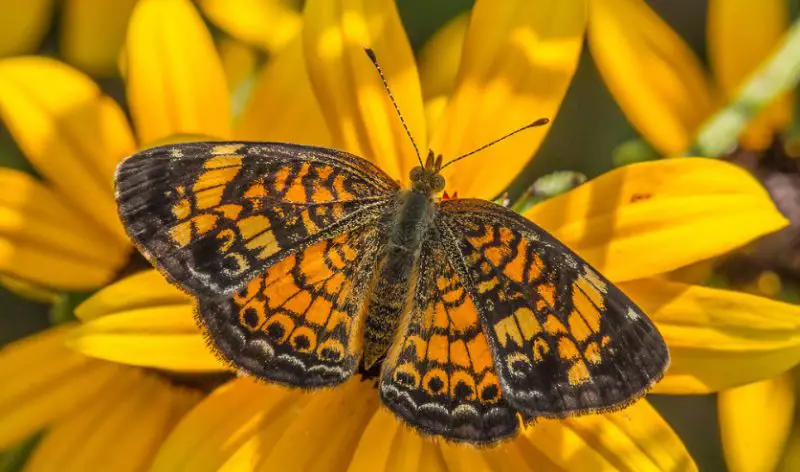
The Pearl Crescent is a small but striking butterfly with bright orange wings edged in black, often dotted with fine black markings. The pattern varies slightly among individuals, making them a bit tricky to identify, but the overall look is consistent with low-flying orange-and-black butterflies. The undersides are paler, with a complex pattern of browns and grays.
In Georgia, Pearl Crescents are abundant in open fields, along trails, and in grassy meadows. They prefer low-growing nectar plants and often rest close to the ground. The primary host plant for the caterpillars is aster, which is commonly found in the wild across much of the state. Adults can be seen from spring through fall.
A fun fact about the Pearl Crescent is its tendency to form local colonies. While individuals may roam widely, many often stay within a small area for their entire adult lives, making it possible to see the same butterflies visiting the same flowers day after day.
Viceroy (Limenitis archippus)
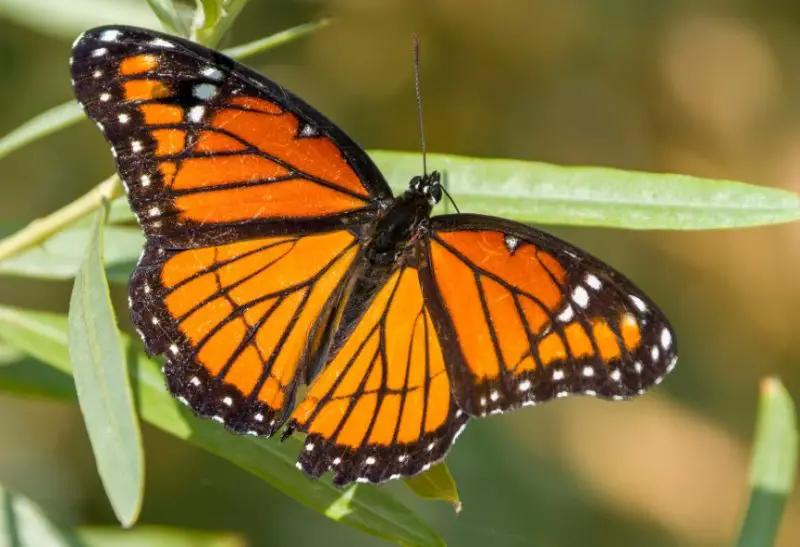
The Viceroy butterfly closely resembles the Monarch but is smaller and can be distinguished by a distinctive black horizontal line crossing the hindwings. This line helps separate it from Monarchs, whose hindwings lack such markings. The Viceroy’s coloration mimics the Monarch’s bright orange and black pattern, serving as a classic example of Batesian mimicry, where a harmless species imitates a toxic one for protection.
In Georgia, Viceroys are commonly found near wetlands, ponds, and along forest edges where their host plants—willows, poplars, and cottonwoods—are abundant. Their caterpillars feed on these trees, while adults are often seen fluttering around water sources or nectaring on flowers such as milkweed and asters.
A fascinating fact about the Viceroy is that for a long time it was believed to be harmlessly mimicking the toxic Monarch to avoid predators. However, recent studies suggest that the Viceroy itself is unpalatable, making it a case of Müllerian mimicry, where both species benefit by sharing a warning appearance.
Variegated Fritillary (Euptoieta claudia)
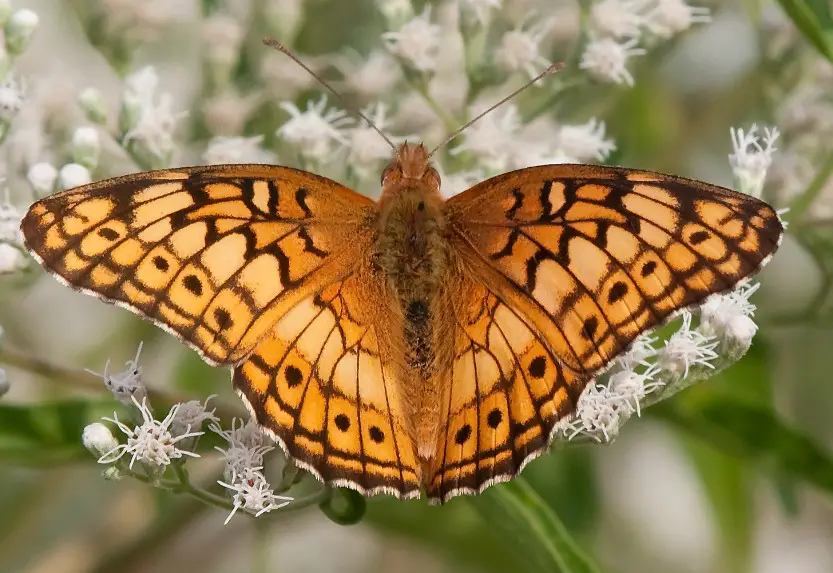
The Variegated Fritillary is a medium-sized butterfly with a warm orange-brown coloration covered in complex, mottled black patterns. Its wings are adorned with numerous spots and streaks, giving it a “busy” or variegated appearance that helps it blend into grassy and wildflower-rich habitats. The undersides of the wings are paler with muted patterns, providing camouflage when at rest.
This butterfly is common in Georgia’s open fields, meadows, and disturbed areas where wildflowers flourish. Its caterpillars feed on a variety of host plants including passionflower, violets, and plantain. Adults are strong fliers and often seen basking in sunny spots or feeding on nectar from daisies, clovers, and other native flowers.
An interesting fact is that Variegated Fritillaries are known for their restless flight, often darting quickly and erratically as they move through open landscapes. This behavior, combined with their camouflaged appearance, helps them avoid predators in exposed habitats.
Long-tailed Skipper (Urbanus proteus)
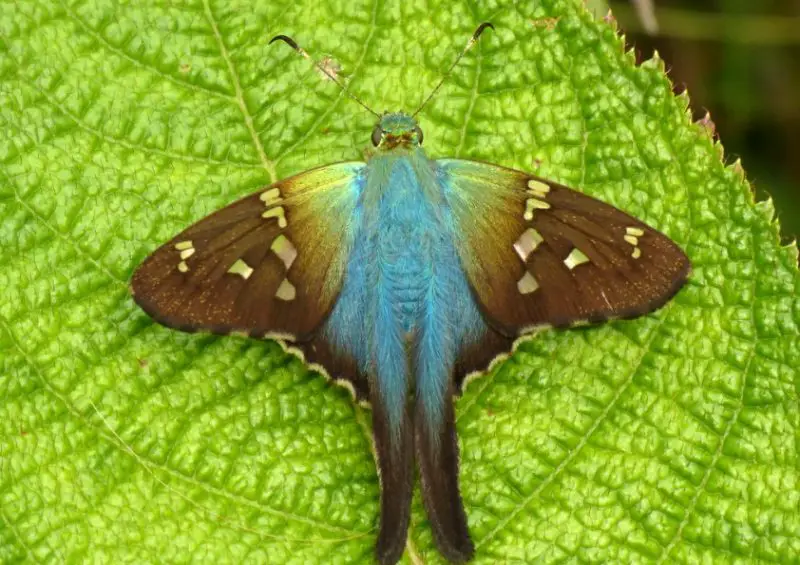
The Long-tailed Skipper is a distinctive butterfly easily identified by two long, slender “tails” extending from its hindwings. Its wings shimmer with a beautiful iridescent blue-green sheen over a brownish background, giving it a striking appearance unlike most other skippers. The body is robust and covered with fine hairs, typical of skipper butterflies.
In Georgia, this species is most often found in gardens, fields, and along roadsides where its host plants, mainly beans and legumes, grow. The caterpillars feed on these plants and construct leaf shelters by folding or rolling leaves with silk. Adults feed on nectar from a variety of flowers, including lantana and shepherd’s needle.
A fun fact about the Long-tailed Skipper is that its rapid, darting flight pattern, combined with its unusual wing tails, helps it evade predators. These tails may also confuse predators by drawing attacks away from the butterfly’s vital body parts.
Sleepy Orange (Eurema nicippe)

The Sleepy Orange is a small, fast-flying butterfly with bright orange wings bordered by a thin black edge. Its coloration is more intense than some related species, and the undersides of the wings are pale yellow with faint markings. Despite its small size, the Sleepy Orange is very active and often seen fluttering low over sunny fields and roadsides.
In Georgia, Sleepy Oranges favor open, sunny habitats, including meadows, gardens, and fields with their preferred host plants such as wild senna and partridge pea. Caterpillars feed on these plants, while adults visit nectar sources including clover, lantana, and tickseed.
A charming fact about the Sleepy Orange is that it is most active during the early morning hours when the sun warms the landscape. Its rapid flight and bright color make it one of the most energetic and noticeable butterflies in Georgia’s early day.
Little Sulphur (Eurema lisa)
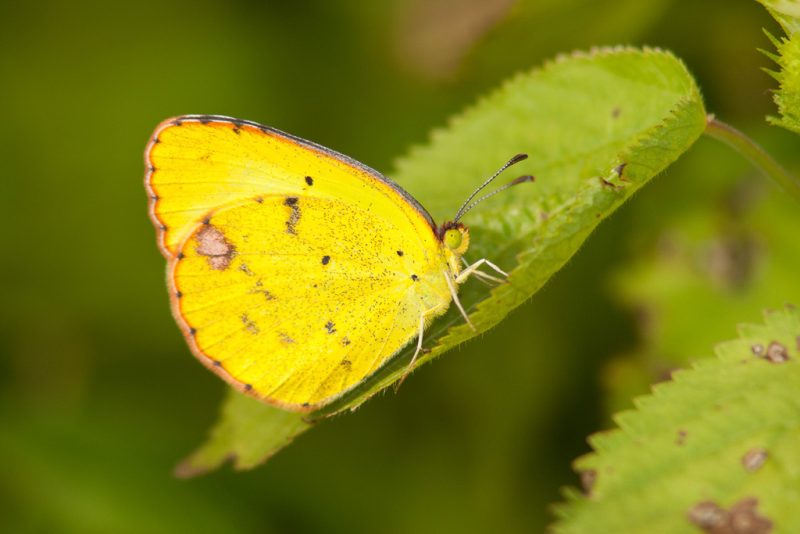
The Little Sulphur is a petite butterfly closely related to the Cloudless Sulphur but smaller and paler in coloration. Its wings are a soft, light yellow, often tinged with white, and it flies low to the ground with a gentle, fluttering motion. This species is less conspicuous but widespread in dry grasslands and open fields.
In Georgia, Little Sulphurs are frequently found in dry, sandy areas, meadows, and pastures where legumes such as partridge pea serve as host plants. The adults feed on nectar from flowers like aster and clover. Their subtle color and small size make them easily overlooked but important components of the local butterfly community.
A notable fact about the Little Sulphur is its preference for drier habitats compared to the Cloudless Sulphur. It often shares the same general range but tends to inhabit more xeric (dry) environments, showcasing the diversity of sulphur butterflies in Georgia.
Red-banded Hairstreak (Calycopis cecrops)
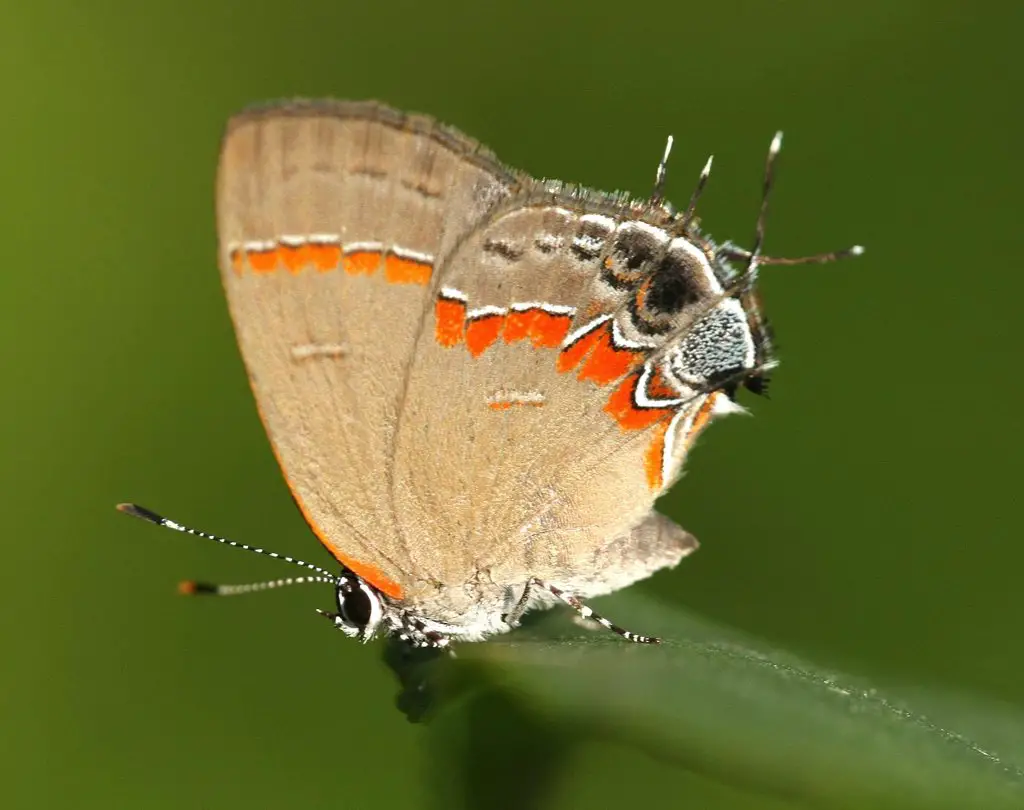
The Red-banded Hairstreak is a small, delicate butterfly notable for its grayish wings adorned with a bright red band running across the hindwings. Each hindwing also has tiny “tails” that resemble small antennae, a common trait in hairstreak butterflies that helps confuse predators. Its subtle coloration allows it to blend well into shrubby, low vegetation habitats.
In Georgia, this species is frequently found in open woodlands, thickets, and shrubby areas where it can easily perch on leaves and twigs. The Red-banded Hairstreak favors low-growing plants as host plants, including various legumes and mistletoes. Adults feed on nectar from flowers such as dogbane and milkweed.
A fun fact about the Red-banded Hairstreak is that its small “tails” and vibrant red markings can trick predators into attacking the less vital parts of its wings, increasing its chances of escape during an attack. This clever adaptation helps explain its widespread success in various habitats.
Gray Hairstreak (Strymon melinus)
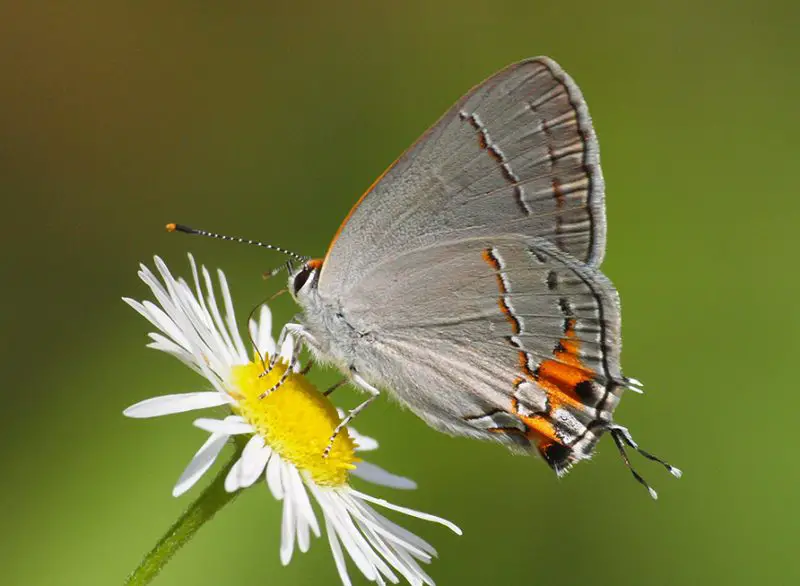
The Gray Hairstreak is one of the most common hairstreak butterflies in North America, easily recognizable by its silver-gray wings and a thin, delicate tail on each hindwing. It has small orange and black spots near the tails that add a splash of color to its otherwise muted tones. When at rest, the wings are closed, showing the gray underside with subtle markings.
In Georgia, the Gray Hairstreak is found in diverse habitats including gardens, fields, and woodland edges. Its caterpillars feed on a wide range of plants such as mallows, legumes, and cotton, making it highly adaptable. Adults often perch on low vegetation and are frequently seen nectaring on flowers like asters and clovers.
An interesting fact about the Gray Hairstreak is its remarkable adaptability; it can thrive in urban, suburban, and rural environments. Its broad host plant range helps it survive and reproduce successfully across varied landscapes in Georgia.
Dainty Sulphur (Nathalis iole)
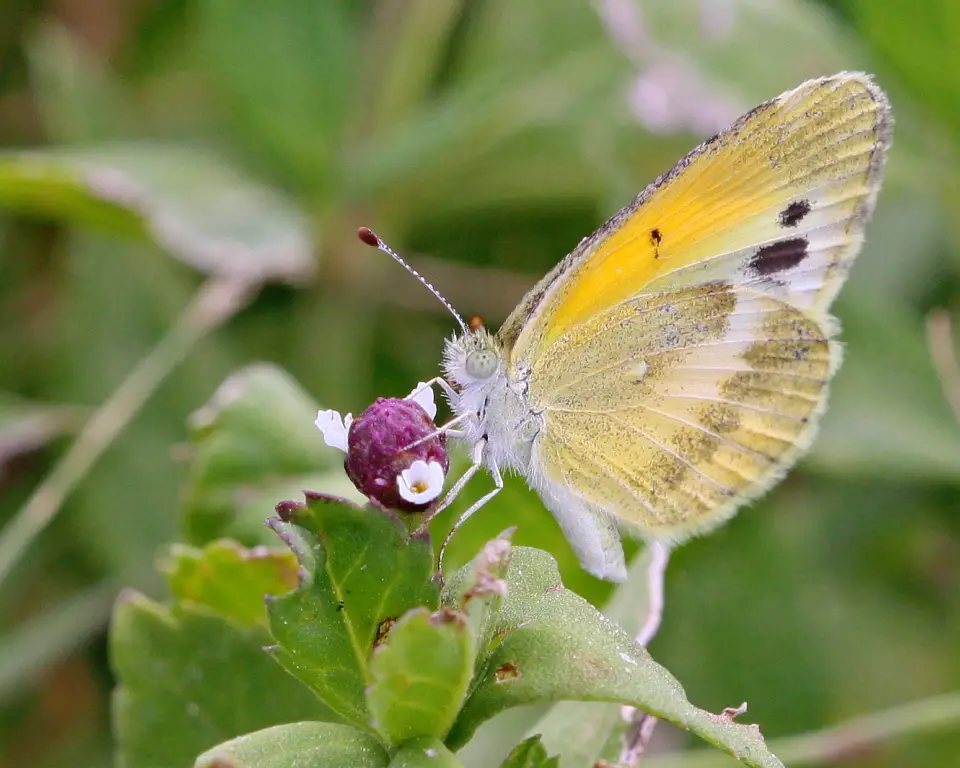
The Dainty Sulphur is one of the smallest butterflies in the sulphur family. It is bright yellow with fine black lines and spots decorating its wings, giving it a delicate, lacy appearance. Despite its small size, the Dainty Sulphur is easily spotted due to its quick, fluttery flight and preference for sunny, open areas.
In Georgia, this butterfly is commonly found in grasslands, weedy fields, and sunny roadside patches where low-growing plants provide both nectar and host resources. Caterpillars feed primarily on plants in the pea family, and adults are especially attracted to flowers like shepherd’s needle and tickseed.
A charming fact about the Dainty Sulphur is its tendency to fly close to the ground, often near patches of bare soil or dried vegetation. This behavior makes it easier to miss, but also helps it avoid predators by staying low and hidden among grasses.
Common Checkered Skipper (Pyrgus communis)
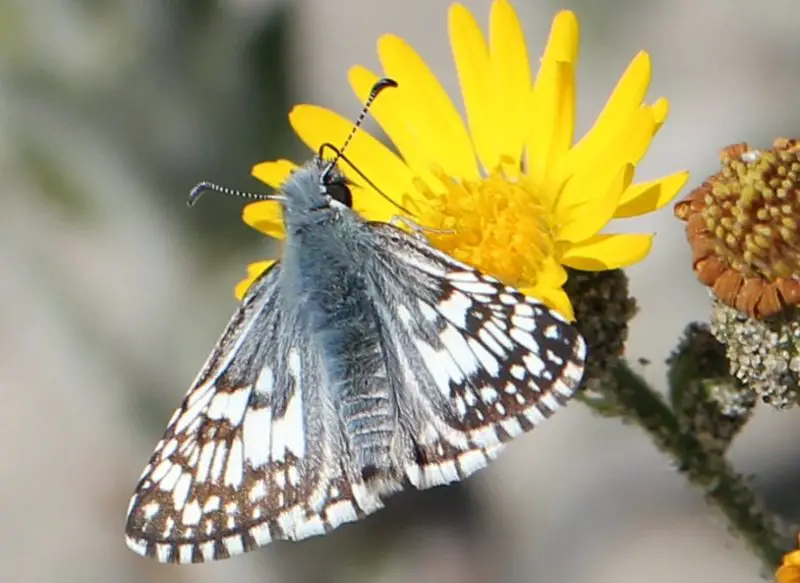
The Common Checkered Skipper is a small butterfly with wings patterned in a distinct checkered design of pale gray-green and white spots resembling a chessboard. Its robust body and quick, erratic flight make it a lively and recognizable species. When perched, it often holds its wings partially open, showing off its striking pattern.
In Georgia, this skipper favors open, sunny habitats such as fields, gardens, and disturbed areas with low vegetation. The caterpillars feed on plants in the mallow and hibiscus families, while adults visit a variety of nectar sources including clovers and asters. They often rest close to the ground or on low leaves.
A fun fact about the Common Checkered Skipper is that despite its small size, it is an aggressive flyer and territorial. Males often defend small patches of habitat, chasing away intruders in quick, jerky flights.
Zebra Swallowtail (Eurytides marcellus)
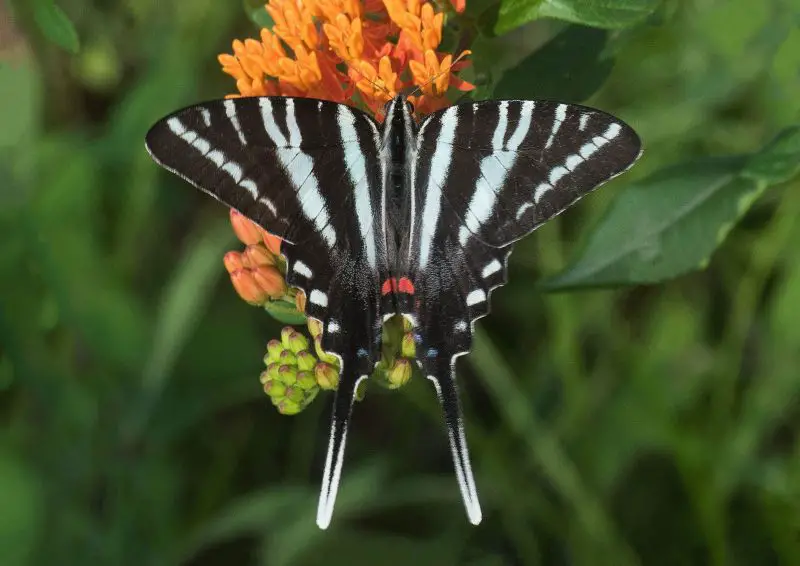
The Zebra Swallowtail is a breathtaking butterfly distinguished by its long, narrow wings with bold black and white stripes reminiscent of a zebra’s pattern. Two long tails extend from each hindwing, adding to its graceful, elegant appearance. The delicate wing shape and contrasting colors make it one of the most beautiful butterflies in Georgia.
This species is closely tied to pawpaw trees (Asimina triloba), which are the host plants for its caterpillars. In Georgia, Zebra Swallowtails are usually found near pawpaw groves, forest edges, and shaded riverbanks. Adults feed on nectar from a variety of flowers and have a slow, gliding flight that adds to their charm.
A fascinating fact about the Zebra Swallowtail is that its caterpillars produce a foul-smelling chemical from a gland called the osmeterium when threatened. This helps protect them from predators, contributing to the butterfly’s successful survival through its vulnerable larval stage.
FAQs about Butterflies in Georgia
What are the most common butterflies found in Georgia?
Georgia hosts a rich diversity of butterflies, with some of the most common species including the Eastern Tiger Swallowtail, Monarch, Gulf Fritillary, Black Swallowtail, and Spicebush Swallowtail. Other frequently seen butterflies are the Cloudless Sulphur, American Lady, Zebra Longwing, and Painted Lady. These butterflies inhabit a variety of environments such as woodlands, gardens, meadows, and wetlands throughout the state.
When is the best time to see butterflies in Georgia?
The best time to observe butterflies in Georgia is during the warmer months from spring through early fall. Peak butterfly activity generally occurs between April and September when temperatures rise and flowers are abundant, providing ample nectar sources. Migration periods, especially in spring and fall, also bring large numbers of species like Monarchs and Painted Ladies passing through the state.
What plants attract butterflies in Georgia?
Butterflies in Georgia are attracted to a variety of nectar-rich flowering plants such as milkweed, lantana, passionflower, goldenrod, asters, and clover. Host plants, which caterpillars feed on, are equally important and include species like milkweed for Monarchs, spicebush for Spicebush Swallowtails, pawpaw for Zebra Swallowtails, and various legumes for sulphurs and skippers. Planting a mix of native nectar and host plants encourages butterfly presence in gardens and natural areas.
Do butterflies in Georgia migrate?
Yes, several butterfly species in Georgia are migratory. The Monarch butterfly is famous for its long-distance migration to and from Mexico. Painted Ladies and Cloudless Sulphurs also undertake seasonal movements, often appearing in large numbers during migration events. Migration patterns vary by species and can be influenced by weather, food availability, and breeding cycles.
How can I help conserve butterfly populations in Georgia?
Conservation efforts include planting native flowers and host plants, reducing pesticide use, and preserving natural habitats like woodlands, meadows, and wetlands. Creating butterfly gardens with diverse plant species helps provide food and breeding sites. Supporting local conservation programs and educating others about the importance of butterflies in ecosystems can also contribute to their protection.
Are there any rare or endangered butterflies in Georgia?
Yes, Georgia is home to some rare and threatened butterfly species. For example, the Regal Fritillary and the Frosted Elfin are considered vulnerable due to habitat loss. Conservation efforts are ongoing to protect their habitats and raise awareness. Observing and reporting sightings of rare butterflies can help scientists monitor populations and plan effective conservation strategies.
What is mimicry, and which butterflies in Georgia exhibit this behavior?
Mimicry is a natural phenomenon where one species evolves to resemble another, usually to avoid predators. In Georgia, the Viceroy butterfly is a famous example; it closely mimics the toxic Monarch butterfly in coloration and pattern to deter predators, despite being smaller. Similarly, the Spicebush Swallowtail mimics the toxic Pipevine Swallowtail to gain protection. This adaptive strategy enhances survival chances in the wild.
Can butterflies be found year-round in Georgia?
While many butterfly species are seasonal, some can be found year-round in Georgia’s milder southern regions. Species like the Cabbage White and Red Admiral may overwinter as adults and emerge on warm days during winter. However, most butterflies have life cycles tied to warmer weather and are typically absent or in dormant stages during colder months.
How do caterpillars choose their host plants in Georgia?
Butterfly caterpillars are usually highly specialized feeders, selecting specific host plants essential for their growth. Female butterflies lay eggs only on these plants, ensuring their larvae have the correct food. For example, Monarch caterpillars feed exclusively on milkweed, while Zebra Swallowtail caterpillars rely on pawpaw. This close relationship influences butterfly distribution and survival.
What are some interesting behaviors of butterflies in Georgia?
Butterflies exhibit a variety of fascinating behaviors such as territorial defense, mud-puddling, and social roosting. For instance, male Gulf Fritillaries aggressively patrol territories to attract females. Many species, like the Zebra Longwing, roost together at night in large groups for safety. Mud-puddling, where butterflies gather on damp soil to extract minerals, is commonly observed during warm months. These behaviors highlight the complex lives of butterflies beyond their beauty.

